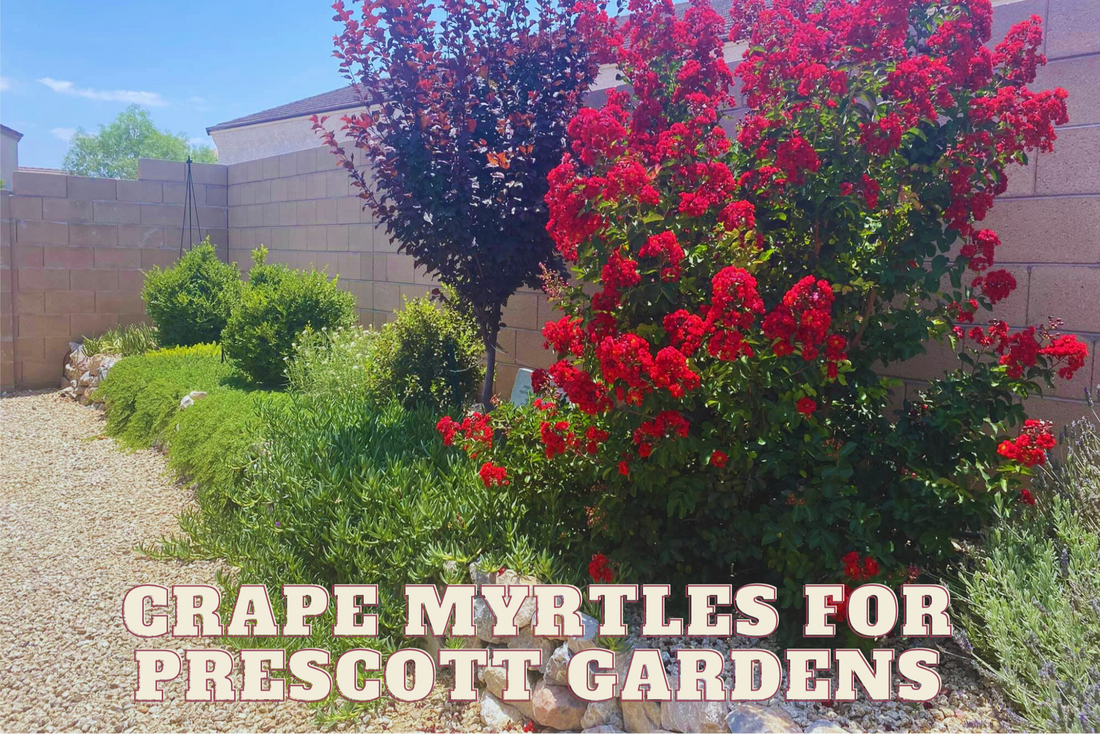
Southern Belle to Mountain Gem: Crape Myrtles for Prescott Gardens
by Ken Lain, the mountain gardener

When I share the secrets to growing crape myrtles in Prescott, gardeners often express surprise. You might think these gorgeous, long-blooming trees are exclusive to warmer climates. Not so! With a bit of know-how, you can enjoy their vibrant summer flowers, beautiful bark, and attractive fall foliage right here in our mile-high climate.
Crape myrtles thrive in our intense Arizona sun, making them perfect for hot, exposed locations where other plants might struggle. They thrive in our dry air and tolerate a wide range of soil conditions as long as the soil drains well. The key to success in Prescott lies in selecting the right varieties and providing proper care, especially during their establishment period.
Choosing the Right Crape Myrtle for Prescott
Not all crape myrtles are created equal when it comes to cold hardiness. For Prescott, it is crucial to choose varieties specifically bred to withstand colder temperatures. Look for cultivars labeled as "cold hardy" or "Mountain hardy." Excellent choices for our region include Pink Slush, Acoma White, Pocomoke Red, Purely Purple, Natchez, and Like a Latte, with its black foliage is striking. These often reach mature heights ranging from dwarf shrubs at 3 feet to stately trees at 20 feet, so select a size that fits your garden space.

Planting Your Crape Myrtle for Success
Timing is important for planting crape myrtles. The best time to plant is in Summer after the danger of frost and when the soil has warmed by the summer sun. This gives the plant ample time to establish its root system before the colder temperatures of fall and winter arrive.
When you are ready to plant, dig a hole that is twice as wide as the root ball and just as deep. Loosen the soil at the bottom of the hole. I always recommend blending Watters "Premium Mulch" into the native soil at a 50/50 ratio. This enriches the soil, improves drainage, and helps with moisture retention – all critical for healthy root development. Carefully remove the crape myrtle from its container, gently loosen any circling roots, and place it in the hole so that the top of the root ball is level with the surrounding soil. Backfill the hole with your enriched soil mixture, gently tamping down to remove air pockets.
Watering: The Most Critical Step
Proper water is paramount, especially during the first two seasons after planting. This is when the plant is establishing its root system. Immediately after planting, give your crape myrtle a deep watering. For the first few weeks, water every two to three days, ensuring the soil remains consistently moist but not waterlogged.
Once established, crape myrtles are remarkably drought-tolerant. However, for optimal blooming and growth, they appreciate deep watering every 7-10 days during Prescott's hot summer months. Reduce water frequency in the fall as temperatures cool, and water sparingly, if at all, during winter. Overwatering is a common mistake that can lead to root rot, so always check the soil moisture before watering. Stick your finger a few inches into the soil; if it feels dry, it is time to water.
Fertilizing for Abundant Blooms
Crape myrtles are heavy feeders; a balanced feeding schedule will encourage more prolific blooms and vigorous growth. In early spring, just as new growth begins, apply a slow-release granular fertilizer like Watters 7-4-4 All Purpose Food. This provides a steady supply of nutrients throughout the growing season. Avoid high-nitrogen fertilizers, which can encourage leafy growth at the expense of flowers.
Pruning for Health and Shape
Pruning is essential for maintaining the shape and health of your crape myrtle and encouraging abundant blooms. The best time to prune is in late winter or early spring, before new growth emerges. March is ideal.
Start by removing any dead, damaged, or crossing branches. Then, focus on shaping the tree. Crape myrtles bloom on new wood, so do not be afraid to prune back. Avoid the common mistake of "crape murder," where the tree is severely topped, leaving unsightly stubs. Instead, aim for a more natural, open habit. Remove suckers that sprout from the base of the plant and thin out crowded branches to improve air circulation. For a tree form, gradually remove lower branches to expose the beautiful exfoliating bark.
Winter Protection in Prescott
While the cold-hardy varieties can withstand Prescott winters, a little extra protection for young plants in their first couple of winters can make a big difference. After the ground freezes, apply a 2-4 inch layer of shredded cedar bark around the base of the plant, extending out to the drip line. This insulates the roots and helps prevent frost heave. You can also wrap the trunk of young trees with burlap for added protection during severe cold snaps. Remove the burlap in early spring.
Pest and Disease Resistance
One of the many appealing aspects of crape myrtles is their general resistance to most pests and diseases. Occasionally, you might encounter powdery mildew, especially in humid monsoon conditions or if air circulation is poor. Ensure good air circulation through proper spacing and pruning. Aphids can sometimes be an issue, but a strong spray of water or an application of insecticidal soap will usually take care of them.
By following these guidelines, you can successfully grow stunning crape myrtles in your Prescott garden. Their long season of bloom, attractive bark, and beautiful fall color will add a touch of Southern charm to your landscape, proving that even in the mountains, we can enjoy these magnificent plants.

Take a Free Garden Class and Learn More! Free Garden Classes every Saturday in June @ Watters Garden Center.
June 14 @ 9:30 am - Top 10 Flowers that Love Summer Heat
We share the fastest-growing plants for fast screening. Block unsightly neighbors, enhance your view, and cut noise and light pollution. Design experts are on hand for unique situations.
June 21 @ 9:30 am - Best Trees for Bushels of Fruit
This class shares the most vigorous fruit trees and insider tips for producing bushels of apples, pears, cherries, apricots, plums, peaches, and more. A particular focus is on planting cocktail trees for small-yard success.
June 28 @ 9:30 am – My First Garden - Gardening for Newcomers
This class shares the most vigorous fruit trees and insider tips for producing bushels of apples, pears, cherries, apricots, plums, peaches, and more. A particular focus is on planting cocktail trees for small-yard success.
Until next week, I'll be helping gardeners grow Summer Crape Myrtles here at Watters Garden Center.


